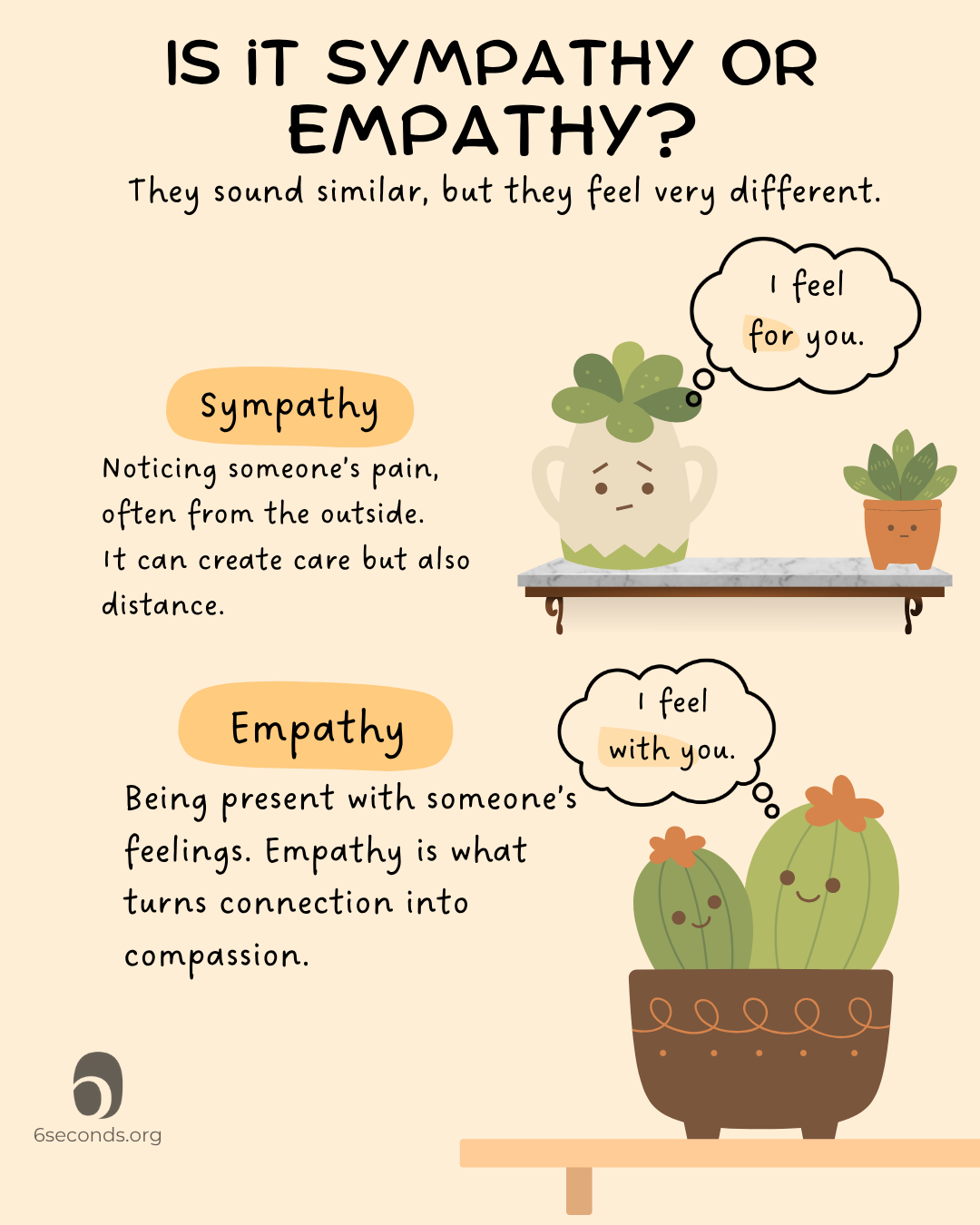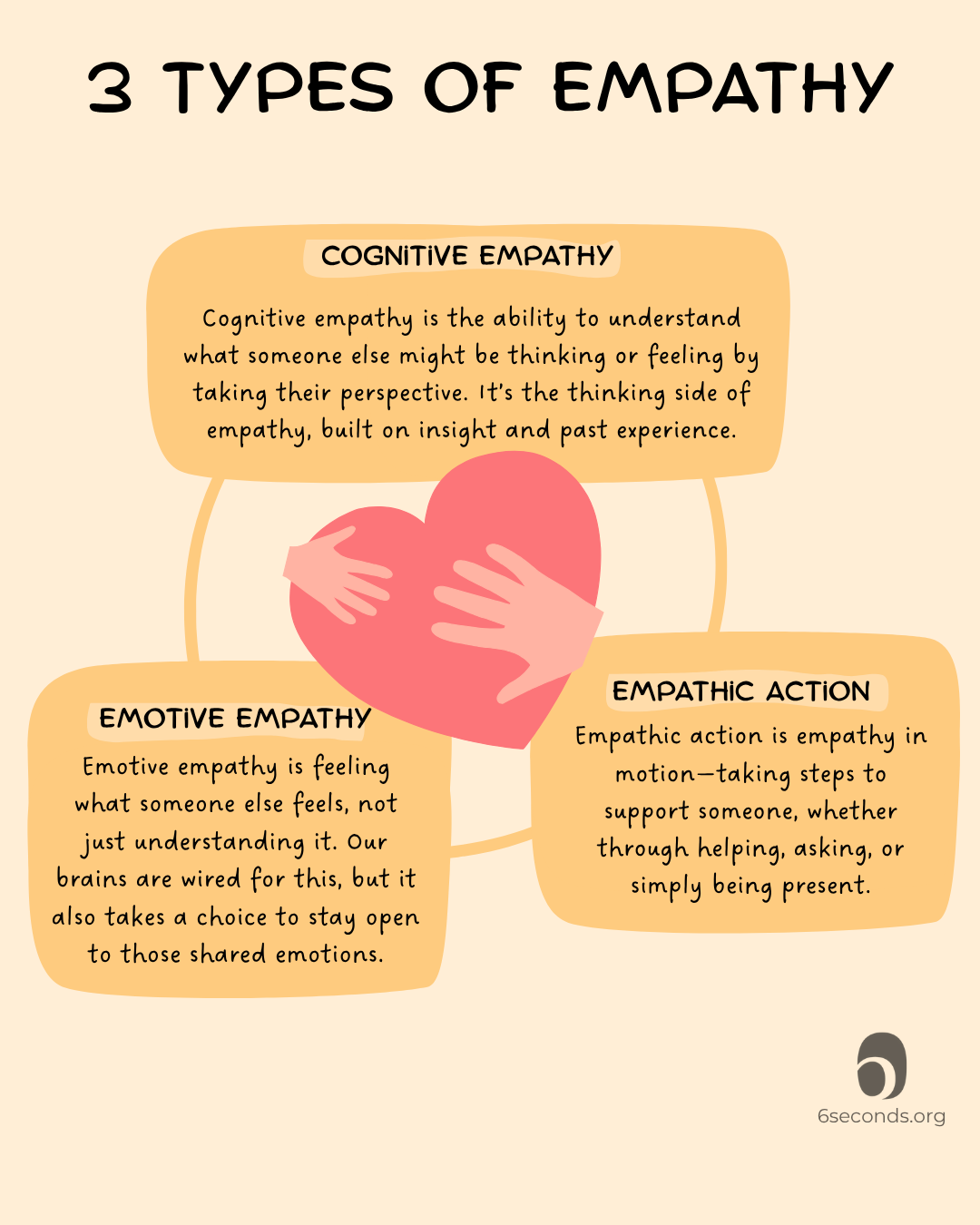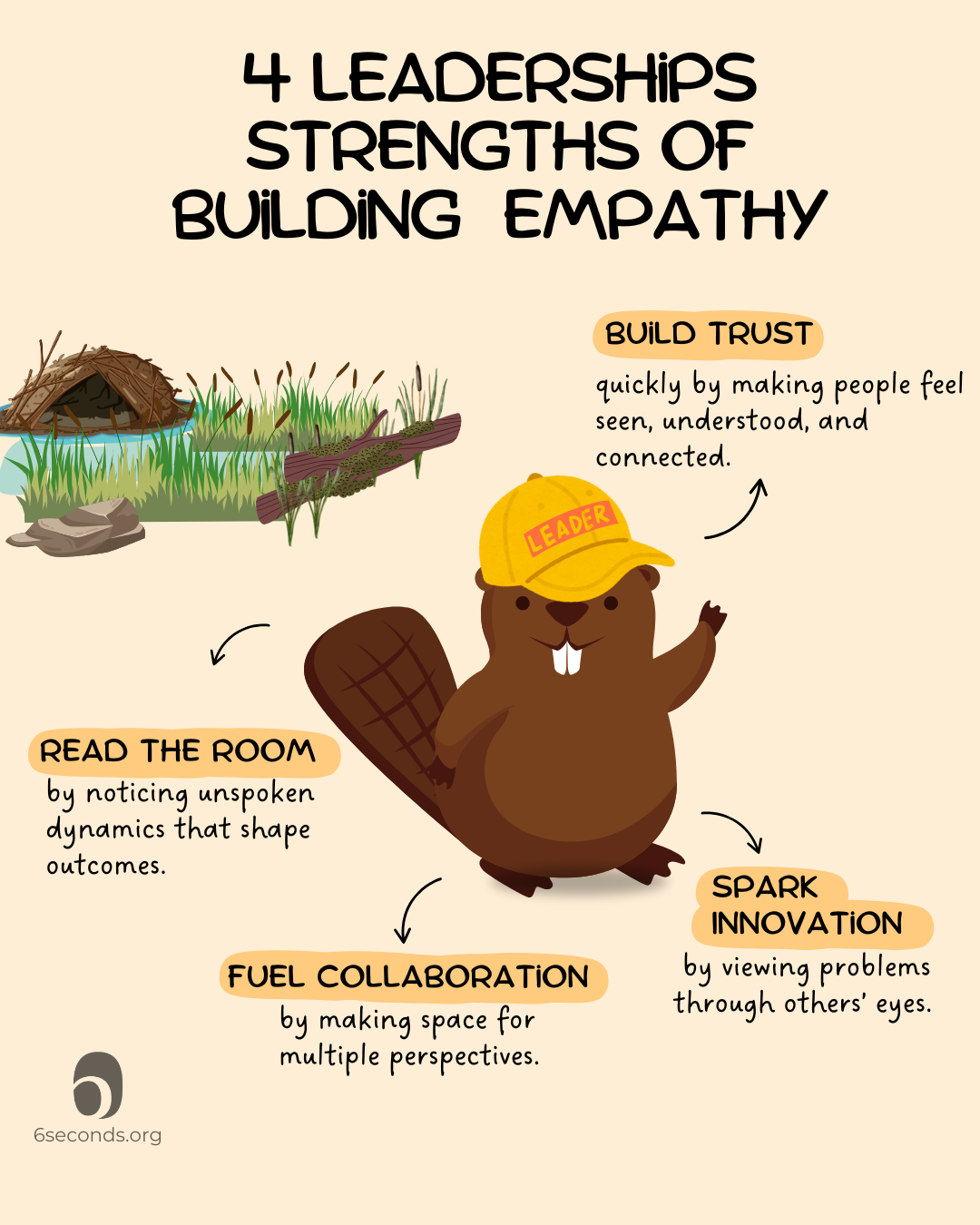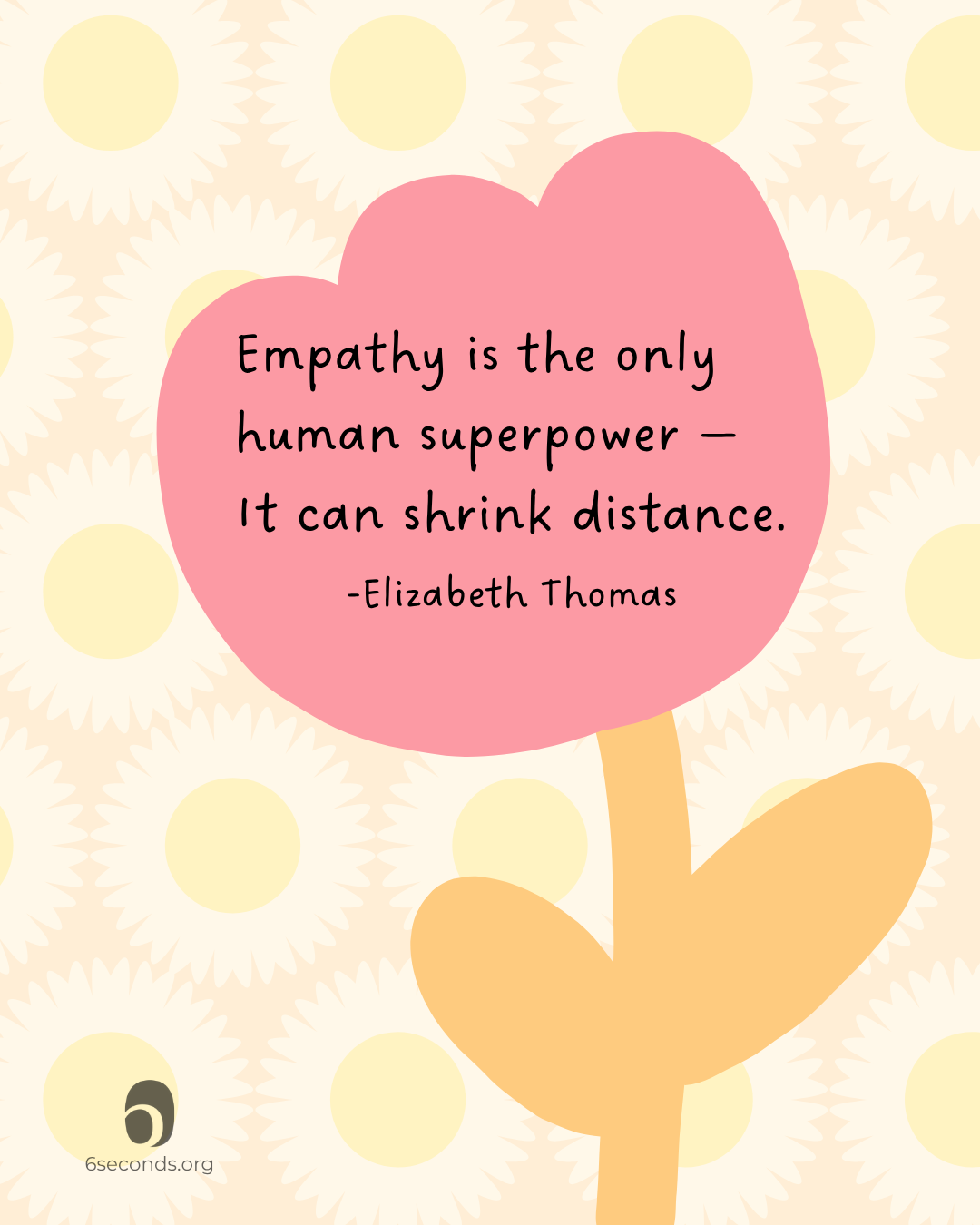
Empathy Isn’t Fragile: Turning Sensitivity into Your Superpower
by Patty Freedman
Do you sometimes feel like you absorb everyone else’s emotions?
People often call themselves an empath—someone who feels things so deeply it can feel overwhelming. On social media, it’s become a popular identity, and while some people celebrate it as a gift, others see it as a curse.
I’ve noticed how easy it is to “catch” someone else’s stress. A friend shares their anxiety, and suddenly I feel it in my own body. At times I’ve wondered: does being so sensitive and attuned to people mean there’s something wrong with me?
At Six Seconds, we see empathy not as fragility but as one of the most powerful capacities in emotional intelligence. When you learn to use it well, empathy becomes a source of strength, connection, and resilience. So let’s dig into the myths and research about empathy.
Empath or Empathy? Debunking the Myth of the “Sensitive Type”
The word empath suggests a special type of person who is destined to feel others’ emotions more deeply than everyone else. That’s the first myth: empathy is not a rare identity, it is a human capacity.
Neuroscience and social neuroscience reviews show that when we resonate with others’ emotional states, brain regions involved in shared affective processing — including the anterior insula and parts of the cingulate cortex — often become active, reflecting neural overlap between self and others’ experiences (Singer & Lamm, 2009; Zaki et al., 2009; Fallon et al., 2020). This is how we experience empathy.
What varies between people is how strongly and how often these systems engage, and whether they’re balanced by brain systems that keep us grounded and put emotions in perspective. Without that balance, the strong messages of empathy can blur the line between your feelings and someone else’s. With balance, empathy can help you connect with others while staying true to your own feelings, becoming a skill we can refine to build trust and relationships
We see this paradox clearly in healthcare. In one study of nurses, higher emotional empathy was linked to compassion fatigue — a vivid example of what happens when resonance overwhelms regulation (Duarte et al., 2016).
Empathy vs. Sympathy: Why Feeling With Someone Changes Everything
Empathy and sympathy get mixed up all the time, but they are not the same. Sympathy means feeling for someone: “I’m so sorry this is happening.” Empathy means feeling with someone: “I can imagine how overwhelming this must feel.”
This distinction matters. Sympathy can create distance — it risks putting one person below the other. Empathy creates connection, a sense of “we’re in this together.”
The myth is that empathy and sympathy are interchangeable. In reality, empathy is multidimensional. Psychologists identify at least three types: cognitive empathy (understanding another’s perspective), emotive empathy (feeling alongside them), and empathic action (turning that resonance into steps of support). Neuroscience and psychology research show that empathy — especially when it leads to action — predicts prosocial behavior such as helping, caring, and cooperation, whereas sympathy does not reliably create those outcomes (Batson, 2011, Decety & Cowell, 2014).
The challenge is that sympathy can feel safer, because it acknowledges someone’s pain without requiring us to step into it. But the opportunity is deeper: empathy asks more of us, and it opens the door to act. Whether it’s offering help, asking a thoughtful question, or simply being present, empathy moves us beyond recognition into response — and that’s where real trust and change are built.

The Superpower of Empathy: A Hidden Strength for Leaders and Teams
The myth is that empathy makes us fragile or overly emotional. The truth is the opposite: empathy doesn’t make us weaker, it makes us wiser
When we practice empathy with balance, it becomes a leadership strength that fuels better decisions and stronger relationships. Empathy can show up as four leadership strengths that directly impact team performance:
- Read the room by noticing unspoken dynamics that shape outcomes.
- Build trust quickly by making people feel seen, understood, and connected.
- Fuel collaboration by making space for multiple perspectives.
- Spark innovation by viewing problems through others’ eyes.
The challenge is that some leaders hesitate to lean on empathy, fearing it will make them appear weak or slow down decision making. Yet the opportunity is far greater: empathy sharpens insight, strengthens trust, and boosts workplace engagement.
Research bears this out. A recent study found that leaders who paired empathy with self-regulation were more effective at building resilience in their teams and reducing turnover intentions (Wibowo, 2022). Other research shows that leaders rated high in empathy are consistently evaluated as more effective overall, with stronger collaboration and employee engagement (Gentry, Weber, & Sadri, 2007, Center for Creative Leadership).
Zenger Folkman found that leaders who regularly demonstrate trust- and empathy-building behaviors, core outcomes of EQ, experience turnover rates 40% lower than their peers, along with higher productivity and satisfaction scores.
Empathy, then, is not a soft skill to be sidelined — it is a superpower for leadership and collaboration.


The Shadow Side of Empathy: When Feeling Too Much Hurts
The myth is that more empathy is always better. In reality, empathy without boundaries can become overwhelming. Too much unfiltered empathy can feel like an emotional tsunami. When we take on others’ pain as if it were our own, we risk compassion fatigue and burnout.
A recent systematic review in BMC Nursing found that empathy and burnout are closely related, but the impact depends on mediating factors such as emotional regulation and self-care (Zhou et al., 2025). This means that empathy on its own isn’t the problem — it’s empathy without balance.
Importantly, neuroscientists caution us not to confuse empathy with empathic distress. When empathy becomes unregulated, it can tip into emotional contagion — absorbing others’ stress so fully that it overwhelms our own capacity. This empathic distress is what leads to exhaustion and burnout. By contrast, compassion — empathy combined with care, perspective, and regulation — is protective. Studies show that compassion activates brain circuits that sustain resilience and buffer against the costs of emotional overload (Hofmeyer et al., 2020).
The opportunity is to shift empathy from a source of burnout to a sustainable resource. When paired with regulation — naming feelings, practicing self-care, and keeping perspective — empathy moves beyond emotional contagion and becomes a steady, compassionate presence.
EQ Tools to Protect Your Sensitivity and Empower Your Empathy
If you identify as highly sensitive, the key is not to shut your empathy down but to use it wisely. Research on self-compassion shows that simple practices can reduce stress and prevent burnout (Neff et al., 2020). Here are a few ways to keep empathy empowering rather than overwhelming:
- Anchor in self-empathy. Ask: “What am I feeling right now?” Naming your own emotions first prevents overload.
- Name, don’t blame. Notice others’ feelings without absorbing them: “I sense tension here” instead of “I feel tense.”
- Shift from absorbing to choosing. Instead of carrying someone else’s emotions, decide how you want to respond.
These small shifts turn sensitivity into strength, helping you stay grounded while using empathy as a resource.
📥 For more practices — including a daily reflection and an empathy balance check — download the 4 Empathy Practices worksheet by filling out the form below.

Download your free worksheet to transform empathy from overwhelm into strength.
Learn four skills to expand your empathy practice to set emotional boundaries, stay grounded, and lean into compassionate connection.
Fill out the form to get your free worksheet now!
Final Reflection: Sensitivity Is Your Strength
Empathy isn’t fragility. It’s not something to fear or avoid. It’s a signal, an opening, a pathway to connection. If you’ve ever been told you’re “too sensitive,” remember: empathy isn’t a flaw. With awareness and practice, it becomes a superpower.
So this month, notice where your empathy shows up. Practice noticing both your own feelings and others’. Protect your sensitivity, and let empathy become a source of strength, resilience, and connection.

For more articles, I recommend:
- No Rest for the Weary: Why Cultivating Rest Is an Art and a Science - November 7, 2025
- Empathy Isn’t Fragile: Turning Sensitivity into Your Superpower - October 7, 2025
- Anticipation is Joy in Advance - September 8, 2025
